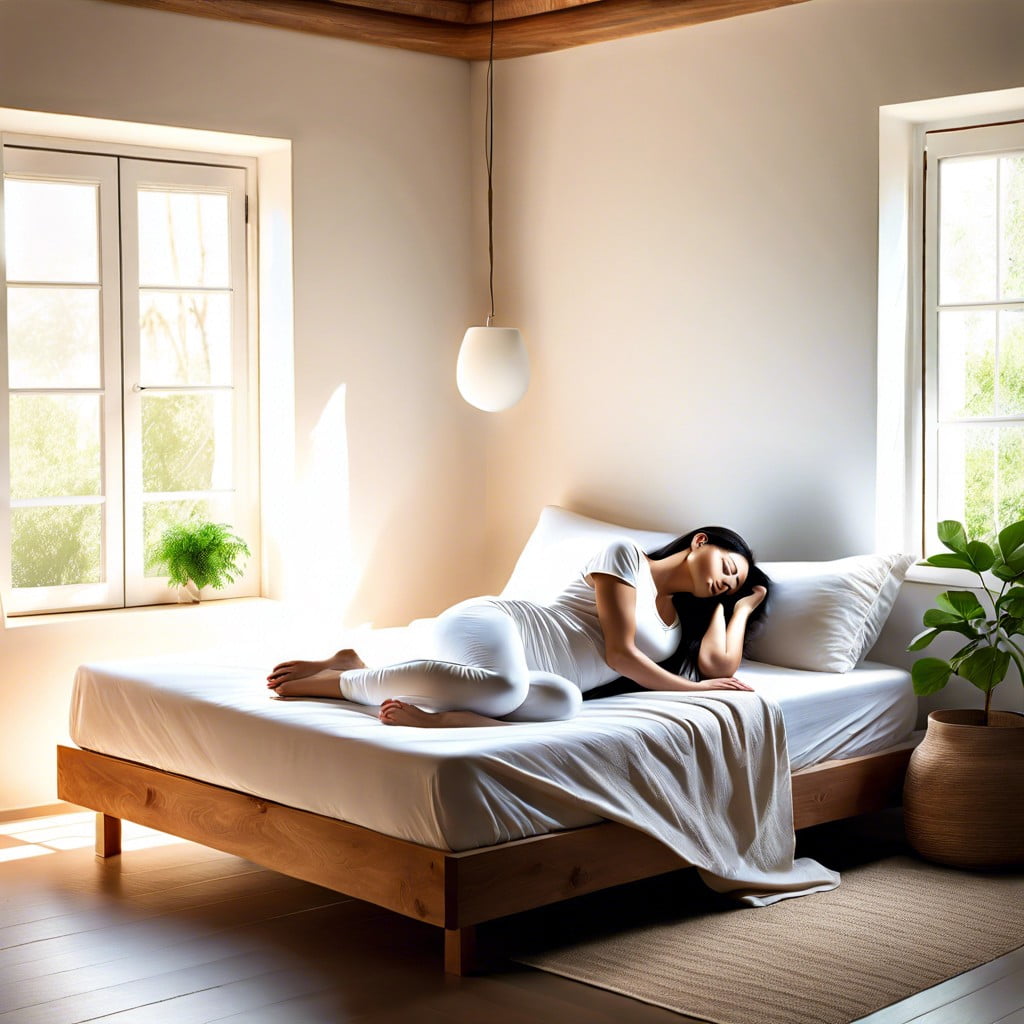You’ll learn whether lying down to meditate fits with traditional practice and how it might affect your mindfulness journey.
Key takeaways:
- Meditating lying down is acceptable and beneficial.
- Lying down may improve relaxation and accessibility.
- Meditating in bed can enhance relaxation and sleep quality.
- Align your body and focus on breath for lying down meditation.
- Try techniques like savasana, visualizations, and body scan.
Can You Meditate Lying Down?

Absolutely, lying down is a viable posture for meditation. Traditionally, meditation is associated with seated positions, but comfort and personal preference play significant roles in a successful practice. Here are key points to consider:
- Alignment: On your back, allow your spine to naturally curve, avoiding strain. A pillow under your knees can alleviate lower back pressure.
- Alertness: The challenge here is maintaining wakefulness. To prevent dozing off, focus on your breath or practice a guided meditation to keep your mind engaged.
- Relaxation: For those with physical discomfort or injury, reclining may facilitate a deeper sense of ease, conducive to mindfulness and relaxation.
- Accessibility: This position can be especially beneficial for people with mobility issues, making meditation inclusive and adaptable to various needs.
Remember, the goal of meditation is to cultivate awareness and serenity. If lying down serves your body and mind well, it’s more than acceptable—it’s sensible.
Benefits of Meditating in Bed
Slipping into a meditative state as you recline may be just what the doctor ordered after a long day. Consider this: your bed is a sanctuary of comfort, a place where relaxation is already a built-in feature. By choosing to meditate here, you’re capitalizing on this calm atmosphere, allowing your mind and body to easily transition into a peaceful state.
Do your mornings feel like a sprint? Well, starting the day with a few minutes of supine meditation can set a serene tone for the hours ahead. It’s like giving yourself a tranquility tune-up before the daily hustle begins.
For those who experience joint pain or mobility issues, lying down is a game-changer. Your body can fully relax without the strain of sitting upright, making meditation an accessible and pain-free experience.
And here’s something to ponder as you nestle into your pillows: studies suggest that relaxation is deeper and quicker to achieve when the body is horizontal. So, you’re essentially getting an express pass to the benefits of mindfulness, such as lower stress levels and improved sleep quality.
Remember, there’s no one-size-fits-all when it comes to meditation postures. The key is to find what works best for you, and if lying down opens the door to consistency and comfort in your practice, then it’s more than okay—it’s a wise move.
How to Meditate in Bed
Before you hit the hay, consider this simple bedtime ritual to quiet your mind. Slide into your comfiest PJs and shuffle into the sanctuary of your sheets. Ensure your mattress is your ally in this journey, providing a firm yet comfortable base. Now, picture your body as a handful of sand cascading evenly across the bed—your aim is to distribute your weight symmetrically. The trick is to keep your spine aligned like a string of pearls, straight but not rigid.
Place a pillow beneath your knees if a twinge in your lower back threatens to intrude on your serenity. If your neck craves support, adjust the plushness of your headrest accordingly. Allow your arms to rest by your sides, palms facing the heavens as if receiving tranquility from above. Close your eyes gently; squinting might make you feel like you’re trying to peer into your own soul.
Now, let your breathing mold to the rhythm of a serene sea—inhale slowly through your nose, filling your chest and belly, then release through your mouth as if you’re sighing away the day’s burdens. Focus on the sensation of the air, cool as it enters, warm as it departs, a cyclic reminder of life’s ebb and flow.
Remember, a wandering mind is as natural as daybreak. When thoughts intrude, picture them as clouds scudding across a clear blue sky—an ephemeral presence not worth latching onto. Simply guide your focus back to the breath, your anchor in this calm nocturnal escape. Practice acceptance and patience; with each session, the process will become as instinctive as nestling into your favorite sleeping position.
Recommended Meditation Techniques for Lying Down Practice
Savasana, or the “corpse pose,” is a classic starting point. Lie flat, spread your limbs slightly, and let the floor hold you as you focus on your breath. Imagine stress melting away with each exhale—a sensation akin to sinking softly into warm sand.
Guided visualizations bloom in this horizontal state too. With eyes closed, picture a serene landscape. A trickling stream or a tranquil forest can become an inner sanctuary where thoughts slow, and calm pervades.
Body scan shines when horizontal. Tune into each part of your body in sequence, releasing tension as though a wave of relaxation washes over you from head to toe.
Breath awareness is a bread-and-butter practice; it’s about as uncomplicated as it gets. Breathe naturally and observe the rhythm—no need to alter it, just let your breath be your gentle anchor.
Progressive muscle relaxation involves tensing and relaxing muscle groups. Start at your feet and work your way up, an interplay of engagement and release that often culminates in a more profound quietude.
Mindful listening can be an auditory adventure. Attend to the symphony of sounds around you without judgment. Each note, from the whisper of the wind to the hum of the fridge, becomes a pathway to deeper awareness.
Lastly, loving-kindness meditation infuses the down time with warmth. Cultivate feelings of compassion by envisioning love radiating from you, embracing friends, family, and eventually extending to all beings.
Remember, the goal isn’t to stifle thoughts but to let them pass, clouds on the vast sky of your mind.